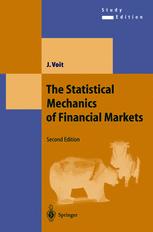

Most ebook files are in PDF format, so you can easily read them using various software such as Foxit Reader or directly on the Google Chrome browser.
Some ebook files are released by publishers in other formats such as .awz, .mobi, .epub, .fb2, etc. You may need to install specific software to read these formats on mobile/PC, such as Calibre.
Please read the tutorial at this link: https://ebookbell.com/faq
We offer FREE conversion to the popular formats you request; however, this may take some time. Therefore, right after payment, please email us, and we will try to provide the service as quickly as possible.
For some exceptional file formats or broken links (if any), please refrain from opening any disputes. Instead, email us first, and we will try to assist within a maximum of 6 hours.
EbookBell Team

5.0
38 reviewsFrom the reviews of the first edition -
"Provides an excellent introduction for physicists interested in the statistical properties of financial markets. Appropriately early in the book the basic financial terms such as shorts, limit orders, puts, calls, and other terms are clearly defined. Examples, often with graphs, augment the reader’s understanding of what may be a plethora of new terms and ideas… [This is] an excellent starting point for the physicist interested in the subject. Some of the book’s strongest features are its careful definitions, its detailed examples, and the connection it establishes to physical systems."
PHYSICS TODAY
"This book is excellent at illustrating the similarities of financial markets with other non-equilibrium physical systems. [...] In summary, a very good book that offers more than just qualitative comparisons of physics and finance." (www.quantnotes.com)
This highly-praised introductory treatment describes parallels between statistical physics and finance - both those established in the 100-year-long interaction between these disciplines, as well as new research results on capital markets.
The random walk, well known in physics, is also the basic model in finance, upon which are built, for example, the Black-Scholes theory of option pricing and hedging, or methods of risk control using diversification. Here the underlying assumptions are discussed using empirical financial data and analogies to physical models such as fluid flows, turbulence, or superdiffusion. On this basis, new theories of derivative pricing and risk control can be formulated. Computer simulations of interacting agent models of financial markets provide insights into the origins of asset price fluctuations. Stock exchange crashes can be modelled in ways analogous to phase transitions and earthquakes. These models allow for predictions.
This new study edition has been updated with a presentation of several new and significant developments, e.g. the dynamics of volatil